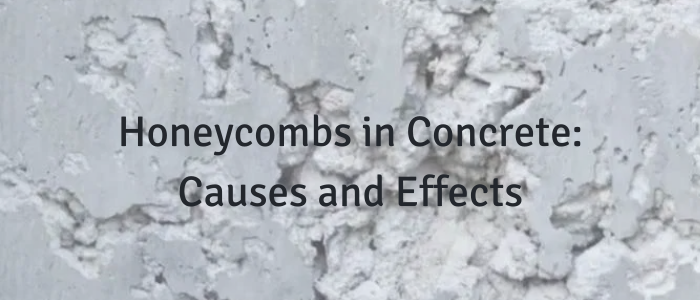Concrete is one of the most durable materials for construction in the modern history. Yet, it might be exposed to some conditions that negatively affect its performance due to distress. Concrete quality might get compromised either during the production stage or during service.
In this article, we are going to discuss concrete honeycombing, one of the most popular surface defects for concrete that reduces the aesthetics and durability of an element.
What is Concrete Honeycombing?

Honeycombs refer to areas of concrete where the cement paste fails to fill the voids around the coarse aggregate and/or steel RFT. The intensity of honeycombs can vary from one or two incidents to the whole surface being affected.
Honeycombs in normal concrete are usually visible once shuttering is removed. However, honeycombs inside the mass of concrete can be identified by techniques like Ultrasonic Testing. Although honeycombs are found in footings, walls, columns, beams, slabs etc., they are more frequent in thin sections and members with high RFT ratio.
Major Causes for Honeycombing
1. Poor Workability of Concrete
2. Defective Formwork
Formworks with loose joints or not leak-proof cause leaking of the cement paste leaving the aggregate and RFT not surrounded by the paste.
3. Improper Compaction
Placing steel RFT at a very close spacing will cause entrapment of the larger pieces aggregates and hinders concrete flow and vibration, resulting in honeycombing.
Effects of Honeycombing
- Honeycombs act as a pathway for the ingress of air and moisture. In a reinforced concrete element, this will cause corrosion of steel that will lead to the loss of the element’s load-bearing capacity.
- Similarly, carbon dioxide will easily diffuse through concrete causing its carbonation.
- The voids present in concrete cause the reduction of compressive strength.
How to minimize Honeycombing
- Use well-graded aggregate and avoid using a very large aggregate size.
- Make sure that concrete mixture is designed to have suitable workability for the job.
- Use a proper compaction method for concrete and avoid placing concrete from more than 1.00 m height.
- Provide sufficient concrete cover and set RFT at a suitable spacing according to the followed code.
- Ensure the formwork does not have any defects.
Read Also: CONCRETE REPAIR AND MAINTENANCE STEPS
